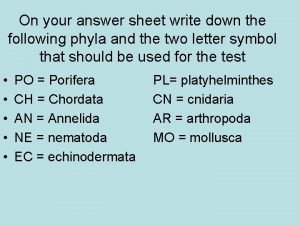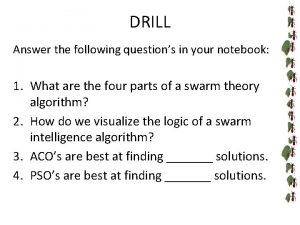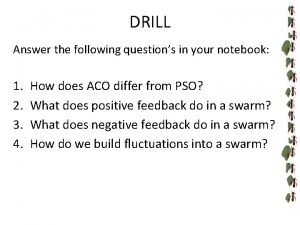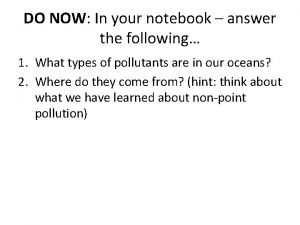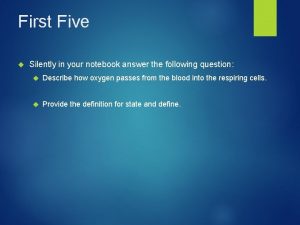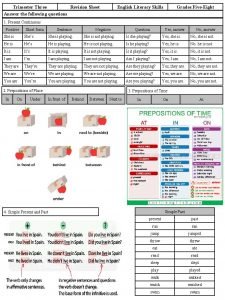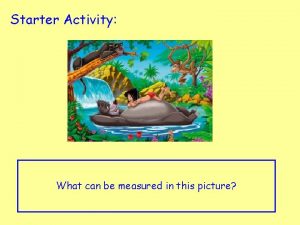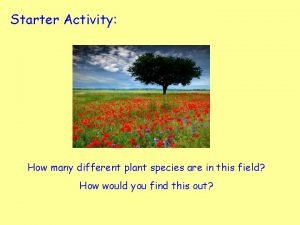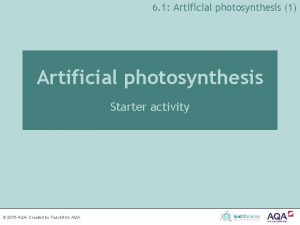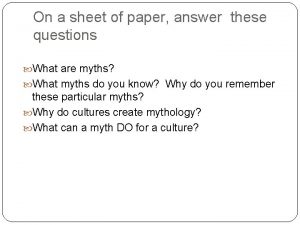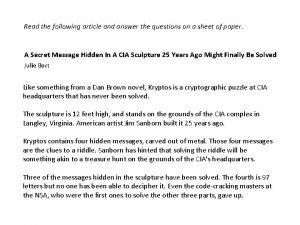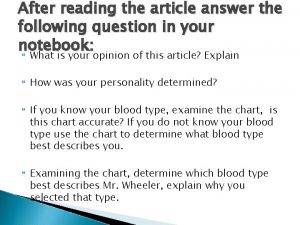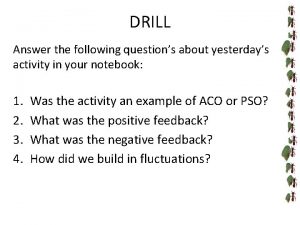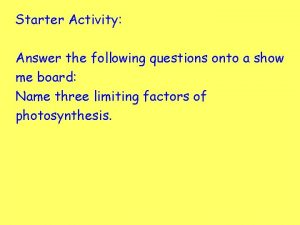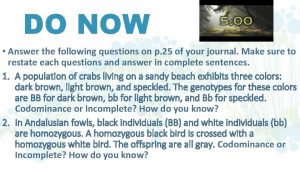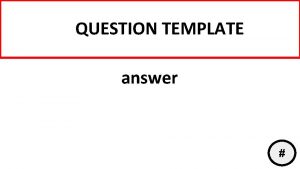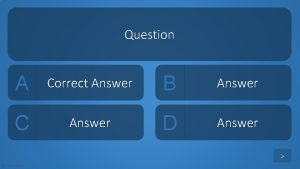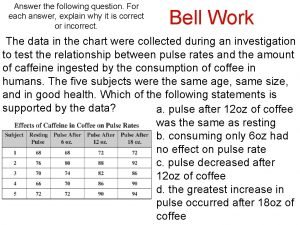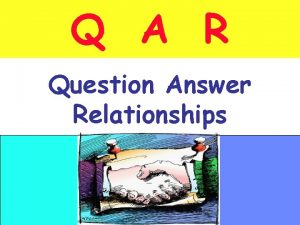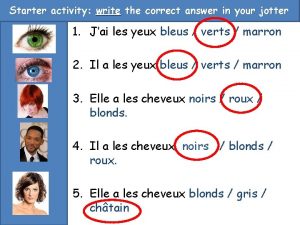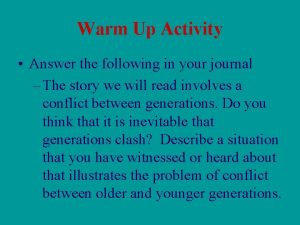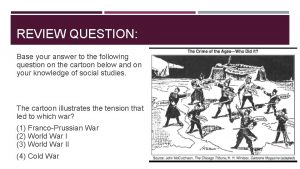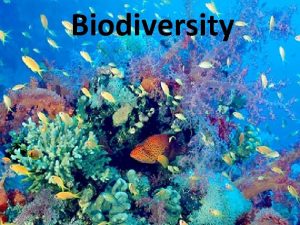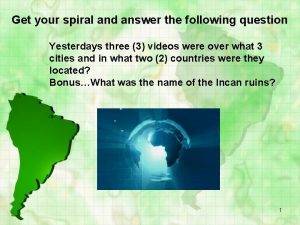Starter Activity Answer the following question in your















































































- Slides: 79

Starter Activity: Answer the following question in your classwork jotter 1. What type of fibres are the cell walls of plants made of? 2. Name the small rings of DNA found in bacterial cells. 3. Name the process by which yeast cells reproduce. 4. What is the function of a) ribosomes? b) mitochondria?

Answers 1. 2. 3. 4. Cellulose Plasmids Budding a) protein synthesis b) respiration

Key Area 2 Transport across cell membranes

Transport across cell membranes Learning Intention: Investigate the cell membrane and the movement of molecules across it Success Criteria: • Be able to describe the structure of the cell membrane • Understand the terms passive and active transport • Understand the term diffusion and give examples of diffusion in cells • Understand the term osmosis and its effect on cells • Understand the idea of concentration gradient

The Function of the Cell Membrane Twig Video Clip: The Cell Membrane Whilst you are watching the video clip write down key words on a show me board.

Structure of the cell membrane • The cell membrane is very thin. • It is able to control the movement of materials into and out of cells. • When seen under an electron microscope, it can be seen to consist of a double layer. Cytoplasm of cell Cell membrane

Structure of the cell membrane • It has a double layer made of molecules called phospholipids. • Phospholipid molecules have a head and a tail end. • All the tails point inward and the heads point outwards. Head end Tails Head end

Structure of the cell membrane • There also proteins embedded in the membrane. • These proteins have various functions. • Some are involved in the transport of materials across the membrane. Phospholipid double layer proteins

Fluid mosaic model • The membrane is a very flexible structure which can move and change shape easily. • It is often described as a fluid mosaic model. • Fluid refers to the moving phospholipids and mosaic refers to the patchy arrangement of the proteins.

Homework task - Make a 3 D cell membrane model • • • Your task is to make a 3 D model of the cell membrane. You can use any materials you can find at home, especially recycling materials. Your model should show the proteins and the phospholipids with their head and tail ends. The component parts should be labelled or there should be a key to identify them. Examples of materials you could use include paper, cardboard, plastic bottle lids, plasticene, playdoh, straws, cotton buds, cocktail sticks, buttons, ribbons, fabric, lolly sticks, dry pasta, lego, stickle bricks, k’nex. THE POSSIBILITIES ARE ENDLESS SO HAVE FUN!

Selectively permeable membrane • Permeability means the ability of a surface to allow molecules to pass through it. • The cell membrane is usually described as selectively permeable. • This means that it allows some molecules to move through it easily, but others move more slowly, and some cannot move across it at all.

Visking tubing • Visking tubing is a selectively permeable material that acts like a cell membrane. • We can use it to demonstrate which molecules are able to pass through the membrane, and which are not. • Your teacher will show you how to use the visking tubing in an experiment.

Visking tubing experiment Water Visking tubing bag Starch and glucose solution Test water for starch and glucose after 20 minutes

Visking tubing experiment 1. 2. 3. 4. 5. 6. 7. 8. Soften a length of visking tubing under running water until you can open it up. Tie a firm knot in one end. Add equal volumes of starch and glucose solutions using droppers. Tie a firm knot in the other end. Cut off any excess tubing to leave 1 cm tails. Wash the bag thoroughly under running water. Place bag in a test tube, cover with water and leave for 20 minutes. Remove the bag. Transfer a drop of the water to a spotting tile and test for starch using iodine. Test the remaining water for glucose by adding Benedicts solution and heating to 80°C for 5 minutes.

Visking tubing experiment Results: Colour change observed Result of test – positive or negative Starch test (iodine) Glucose test (Benedicts) Conclusion : The ______was able to pass through the visking tubing but the _______was not. This is because starch has ____ molecules but glucose has ____molecules.

Selectively Permeable Membranes • Cell membranes allow small molecules like glucose, oxygen and water to pass through them freely. • This is because the membrane has tiny holes in it called pores that make it permeable. Large molecules like starch are unable to pass through.

Selectively Permeable Membranes • Pores in the membrane are small, so only small molecules such as glucose, water, oxygen and carbon dioxide can get through. cytoplasm nucleus • Large molecules such as starch cannot pass through. • Selectively permeable membranes allow certain molecules to pass through but not others. selectively permeable membrane

Transport across cell membranes Learning Intention: Investigate the cell membrane and the movement of molecules across it Success Criteria: • Be able to describe the structure of the cell membrane • Understand the terms passive and active transport • Understand the term diffusion and give examples of diffusion in cells • Understand the term osmosis and its effect on cells • Understand the idea of concentration gradient

Starter

Starter C

Transport across cell membranes Learning Intention: Investigate the cell membrane and the movement of molecules across it Success Criteria: • Understand the terms passive and active transport • Understand the term diffusion and give examples of diffusion in cells

Passive transport • passive transport is the movement of a substance across a cell membrane down a concentration gradient • It does not require energy. • The two types of passive transport are: 1. Diffusion 2. Osmosis

Diffusion • Diffusion is the movement of molecules in a liquid or gas from high to low concentration until they are evenly spread out. • Diffusion moves down a concentration gradient. Diffusion clip


Diffusion in liquids • Diffusion in liquids can be seen by adding dye to a beaker of water. Add dye to one side only Water Do not shake or stir. Leave for 20 minutes.

Diffusion in liquids Red dye in water Red dye molecules and water molecules have moved until they are evenly spread – this is DIFFUSION.

Direction of diffusion Diffusion always occurs from high concentration of a molecule to low concentration of that molecule.

Concentration Gradient The difference in concentration of two solutions is called a concentration gradient. In diffusion, molecules will always move down the concentration gradient from high concentration to low concentration.

Concentration Gradient • Like a ball on a slope, molecules diffuse down a concentration gradient from high to low. high ground ball rolls down gradient ball stops gradient (slope) low ground

Concentration Gradient • A concentration gradient exists when there is a difference in concentration from one area to another. • Molecules move down a concentration gradient from high to lower concentration. The molecules will stop moving when the two concentrations are equal.

Cells and diffusion • Many substances can enter or leave cells by diffusion. • This happens across the cell membrane. • Animal cells take in glucose, oxygen and amino acids by diffusion. • Carbon dioxide and waste materials leave animal cells by diffusion.

Diffusion in an animal cell Glucose Oxygen Amino acids Carbon dioxide Waste

Transport across cell membranes Learning Intention: Investigate the cell membrane and the movement of molecules across it Success Criteria: • Understand the terms passive and active transport • Understand the term diffusion and give examples of diffusion in cells

Starter

Starter Diffusion Waste/carbon dioxide Cell membrane

Transport across cell membranes Learning Intention: Investigate the cell membrane and the movement of molecules across it Success Criteria: • Understand the term osmosis and its effect on cells • Understand the idea of concentration gradient

• Water can also Osmosis diffuse into and out of cells across the cell membrane. • Osmosis is the Low water special diffusion of concentration water from an area of high High water concentration to an concentration area of low concentration through a selectively permeable membrane. Twig Video Clip - Osmosis

Visking tubing • Visking tubing is a selectively permeable material that can be used to show the effect of osmosis on cells. • The visking tubing behaves like a cell membrane, so we can use it to make model cells.

TEACHER DEMONSTRATION Osmosis experiment A B Visking tubing bag 10% sugar solution water Boiling tube 1. Wash and dry bags when filled. 2. Weigh both bags. 3. Place in test tubes for 20 minutes then dry and reweigh.

Results A Mass of bag and contents at start (g) Mass of bag and contents after 20 minutes (g) Difference in mass (g) B

Conclusion • Bag A increased/decreased in mass. This was because water moved in/out by osmosis. • Bag B increased/decreased in mass. This was because water moved in/out by osmosis. • Water always moves from ____ water concentration to ______ water concentration.

Answer the following questions in sentences: 1. Why was the visking tubing bag dried in a paper towel before being weighed? 2. Why was visking tubing used in this experiment? What property does it have that makes it a good model cell? 3. What would happen to an onion cell placed in pure water? 4. What would happen to a cheek cell placed in 10% sucrose solution?

Transport across cell membranes Learning Intention: Investigate the cell membrane and the movement of molecules across it Success Criteria: • Understand the term osmosis and its effect on cells • Understand the idea of concentration gradient

Starter

Starter C

Transport across cell membranes Learning Intention: Investigate the cell membrane and the movement of molecules across it Success Criteria: • Understand the term osmosis Understand the effect of osmosis on plant cells

Osmotic Effect On Cells Water concentrations • If we think about solutions in terms of their water concentrations, it is easier to recognise which direction water molecules will flow in. • A dilute sugar solution will have a high concentration of water, whereas a concentrated sugar solution will have a lower water concentration.

Concentrated Sugar Solution Dilute Sugar Solution Low water concentration High sugar concentration Low sugar concentration

Water Concentrations Cell in pure water Direction of water movement H 2 O concentration > cell The surrounding solution has a higher water concentration than the water concentration within the cell, so water enters by osmosis.

Water Concentrations Cell in concentrated salt solution H 2 O concentration < cell The surrounding solution has a lower water concentration than the water concentration within the cell, so water leaves the cell by osmosis.

Water Concentrations Cell in solution with equal concentration to cell contents. H 2 O concentration = cell The surrounding solution has a water concentration that is equal to the water concentration within the cell, so there is no gain or loss of water by osmosis.

Investigating osmosis in potato tissue 1. Copy the title and the aim from the instruction card. 2. Prepare a results table. 3. Set up the experiment by following the instructions on the card.

Results Bathing solution Water Strong sucrose solution Conclusion Evaluation Initial mass (g) Final mass % Change (g) in mass

Plant Cells and Osmosis Pure water: there is more water outside of the cell than inside, therefore water will move into the cell by osmosis. This causes the cell to swell and become turgid. Strong salt solution: there is more water inside the cell than outside, therefore water will move out of the cell by osmosis. This causes the cell to become softer or flaccid. Cell in pure water Cell in strong salt solution

Plant Cells and Osmosis

Plant Cells and Osmosis Cell in pure water - turgid Normal cell Cell in strong salt solution plasmolysed

Transport across cell membranes Learning Intention: Investigate the cell membrane and the movement of molecules across it Success Criteria: • Understand the term osmosis Understand the effect of osmosis on plant cells

Starter

Starter A

Transport across cell membranes Learning Intention: Investigate the cell membrane and the movement of molecules across it Success Criteria: • Understand the term osmosis Understand the effect of osmosis on animal cells

Viewing plasmolysed cells • In this practical, you will expose onion cells to a solution of salt to observe plasmolysis. You will also prepare cells in water for comparison (as a control experiment). • You will view the cells under the microscope and make drawings of what you see. • You will need a pencil and a circular object (eg beaker) to draw round. • Follow the instructions on the card provided.

Plasmolysis in onion cells • The photo shows onion cells which have been bathed in strong salt solution and have become plasmolysed. • Notice how the cytoplasm and cell membrane have shrunk inwards away from the cell wall cell membrane nucleus cytoplasm

Osmosis in red cabbage cells 1. 2. 3. 4. 5. 6. Your task in this experiment is to identify liquids A and B by looking at the results. Label two boiling tubes A and B. Half fill tube A with liquid A and tube B with liquid B. Cut 10 discs from red cabbage using a cork borer. Wash the leaf discs in a small beaker of water and dry them gently. Add 5 discs to each test tube. Leave for 20 minutes and observe any colour change in the liquids.

Osmosis in red cabbage cells Results: Test tube A Test tube B Appearance of liquid Conclusion: Which test tube contained strong sucrose solution? How do you know this? Which test tube contained water? How do you know this?

Animal Cells & Osmosis • The effects of osmosis on animal cells are totally different to plant cells because animal cell structures are different. • Animals cells do not have: Cell walls Vacuoles

Animal Cells & Osmosis • Red blood cells (RBCs) float in a liquid called plasma which is the same water concentration as the cells. • RBCs in plasma do not change size because the water has no concentration gradient to follow. • RBCs will change if there is a concentration gradient for water to follow.

Animal Cells & Osmosis alt s ong tr s n i ion t C u B l R so RBC in equal concentration solution Normal red blood cell Cell loses water by osmosis and shrinks. No net osmosis, cell stays the same. RB Ci np ure wa ter Cell takes in water by osmosis, swells and eventually bursts.

Osmosis in eggs • Your teacher will show you a demonstration experiment involving eggs placed in different solutions. • Write a description of this experiment in your notebook. Include the following: Title Diagram Method Result Conclusion

Transport across cell membranes Learning Intention: Investigate the cell membrane and the movement of molecules across it Success Criteria: • Understand the term osmosis Understand the effect of osmosis on animal cells

Starter

Starter Turgid

Transport across cell membranes Learning Intention: Investigate the cell membrane and the movement of molecules across it Success Criteria: • Understand the term active transport and its effect on cells • Understand the idea of concentration gradient

Passive transport • Diffusion and osmosis are examples of passive transport. • This always involves movement of molecules down a concentration gradient. • Passive transport does not need any energy input.

Active transport • Some molecules and ions are moved across the membrane by active transport. • This involves movement of molecules and ions against a concentration gradient. • Active transport does need energy input. • Membrane proteins are involved in this process. Transport across cell membranes (Glow)

Active transport

The sodium potassium pump • This is an example of active transport which occurs in nerve cells. • Sodium ions are pumped out of cells against the concentration gradient. • Potassium ions are pumped into cells against the concentration gradient. OUTSIDE THE CELL Sodium pumped out CELL MEMBRANE Membrane proteins Potassium pumped in INSIDE THE CELL

Active transport in cells • When a cell is alive, the membrane can use active transport to make sure that suitable molecules are allowed to build up in the cell, and unsuitable or harmful molecules are kept out of the cell.

Practical application of this idea • You will probably have had antibiotics at some time for an infection. • Many antibiotics work by destroying the membranes of live bacteria in your body. • The damaged membranes allow vital nutrients to escape and poisonous substances to enter and kill the bacterial cells.

Transport across cell membranes Learning Intention: Investigate the cell membrane and the movement of molecules across it Success Criteria: • Understand the term active transport and its effect on cells • Understand the idea of concentration gradient
 On your answer sheet answer the following question
On your answer sheet answer the following question Now write in your notebook
Now write in your notebook Answer the following questions in your notebook:
Answer the following questions in your notebook: In your notebook do the following
In your notebook do the following In your notebook answer the question below
In your notebook answer the question below Write answers to the questions in your notebook
Write answers to the questions in your notebook Answer the following questions in your notebook
Answer the following questions in your notebook In your notebook answer the questions using used to
In your notebook answer the questions using used to In your notebook answer the following questions
In your notebook answer the following questions In your notebook answer the following questions
In your notebook answer the following questions Costa questionnaire answers
Costa questionnaire answers Trimester fill in worksheet answers
Trimester fill in worksheet answers Starter activity clipart
Starter activity clipart Starter activity
Starter activity Paired statement key
Paired statement key Photosynthesis starter activity
Photosynthesis starter activity Starter of the day activity soda morning soft start
Starter of the day activity soda morning soft start Starter of the day activity soda morning soft start
Starter of the day activity soda morning soft start How to remember homeostasis
How to remember homeostasis Look at the pictures answer the questions
Look at the pictures answer the questions Answer the following questions in complete sentences
Answer the following questions in complete sentences A smooth texture reflects light evenly
A smooth texture reflects light evenly On a sheet of paper, answer the following questions.
On a sheet of paper, answer the following questions. Look at the picture then answer the question
Look at the picture then answer the question Read the article and answer the questions
Read the article and answer the questions Answer these questions using complete sentences.
Answer these questions using complete sentences. After reading the article answer the following question
After reading the article answer the following question Yesterday's activity
Yesterday's activity Who are they
Who are they Answer the quiz questions in pairs
Answer the quiz questions in pairs Activity answer the following questions
Activity answer the following questions Activity 3 answer the following questions
Activity 3 answer the following questions Favorite book and why interview question
Favorite book and why interview question My favourite food topic
My favourite food topic Write questions for these answers in your notebook
Write questions for these answers in your notebook What is your dream in your notebook write a short text
What is your dream in your notebook write a short text By looking at the picture from your first activity
By looking at the picture from your first activity Look at the following pictures
Look at the following pictures In your journal notebook answer the following questions
In your journal notebook answer the following questions Answer the following in your notebook
Answer the following in your notebook 1. answer the following questions.
1. answer the following questions. In your notebook,describe the following
In your notebook,describe the following Solve each proportion write your answer in your notebook
Solve each proportion write your answer in your notebook Give us your hungry your tired your poor
Give us your hungry your tired your poor Question word simple present
Question word simple present Moderately open question
Moderately open question Contoh remarks
Contoh remarks Factor - isolating question
Factor - isolating question Change direct questions into indirect questions
Change direct questions into indirect questions Example of a compelling question
Example of a compelling question Compelling and supporting questions examples
Compelling and supporting questions examples Hát kết hợp bộ gõ cơ thể
Hát kết hợp bộ gõ cơ thể Ng-html
Ng-html Bổ thể
Bổ thể Tỉ lệ cơ thể trẻ em
Tỉ lệ cơ thể trẻ em Voi kéo gỗ như thế nào
Voi kéo gỗ như thế nào Chụp tư thế worms-breton
Chụp tư thế worms-breton Hát lên người ơi alleluia
Hát lên người ơi alleluia Môn thể thao bắt đầu bằng từ chạy
Môn thể thao bắt đầu bằng từ chạy Thế nào là hệ số cao nhất
Thế nào là hệ số cao nhất Các châu lục và đại dương trên thế giới
Các châu lục và đại dương trên thế giới Công thức tính thế năng
Công thức tính thế năng Trời xanh đây là của chúng ta thể thơ
Trời xanh đây là của chúng ta thể thơ Cách giải mật thư tọa độ
Cách giải mật thư tọa độ 101012 bằng
101012 bằng Phản ứng thế ankan
Phản ứng thế ankan Các châu lục và đại dương trên thế giới
Các châu lục và đại dương trên thế giới Thể thơ truyền thống
Thể thơ truyền thống Quá trình desamine hóa có thể tạo ra
Quá trình desamine hóa có thể tạo ra Một số thể thơ truyền thống
Một số thể thơ truyền thống Bàn tay mà dây bẩn
Bàn tay mà dây bẩn Vẽ hình chiếu vuông góc của vật thể sau
Vẽ hình chiếu vuông góc của vật thể sau Thế nào là sự mỏi cơ
Thế nào là sự mỏi cơ đặc điểm cơ thể của người tối cổ
đặc điểm cơ thể của người tối cổ Thế nào là giọng cùng tên
Thế nào là giọng cùng tên Vẽ hình chiếu đứng bằng cạnh của vật thể
Vẽ hình chiếu đứng bằng cạnh của vật thể Fecboak
Fecboak Thẻ vin
Thẻ vin đại từ thay thế
đại từ thay thế điện thế nghỉ
điện thế nghỉ
